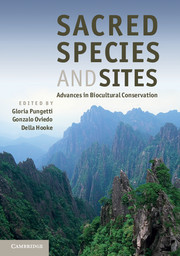Book contents
- Frontmatter
- Contents
- List of Contributors
- Foreword
- Preface
- Acknowledgements
- Introduction
- Part I Concepts and Knowledge
- Part II Sacred Landscapes
- Part III Sacred Sites and People
- Part IV Sacred Species
- Part V Sacred Animals
- Part VI Sacred Groves and Plants
- 21 The sacred tree in the belief and mythology of England
- 22 Sacred groves and biodiversity conservation: a case study from the Western Ghats, India
- 23 Cultural and conservation values of sacred forests in Ghana
- 24 Sacred species of Kenyan sacred sites
- Part VII Implementation and Conclusions
- Index
- Plate Section
- References
22 - Sacred groves and biodiversity conservation: a case study from the Western Ghats, India
from Part VI - Sacred Groves and Plants
Published online by Cambridge University Press: 05 August 2012
- Frontmatter
- Contents
- List of Contributors
- Foreword
- Preface
- Acknowledgements
- Introduction
- Part I Concepts and Knowledge
- Part II Sacred Landscapes
- Part III Sacred Sites and People
- Part IV Sacred Species
- Part V Sacred Animals
- Part VI Sacred Groves and Plants
- 21 The sacred tree in the belief and mythology of England
- 22 Sacred groves and biodiversity conservation: a case study from the Western Ghats, India
- 23 Cultural and conservation values of sacred forests in Ghana
- 24 Sacred species of Kenyan sacred sites
- Part VII Implementation and Conclusions
- Index
- Plate Section
- References
Summary
Introduction
Sacred natural sites provide an apparatus for biodiversity conservation that enjoys support from local people. In addition to their cultural and spiritual significance to local people, such sites protect habitats and species that are excluded from formal protected area networks. Sacred forest groves are patches of forest that support forest-dwelling species within non-forest matrix. The focus of this chapter is particularly on sacred forest groves in the Western Ghats of India. While a network of such groves can contribute to landscape-scale conservation of biodiversity, the quality of the landscape matrix itself is important. In order to maintain the tree-covered matrix around sacred forest groves, local people's support is essential. Although sacred natural sites face challenges due to their uncertain legal ownership and changing religious and cultural values, they have the potential for biodiversity conservation because of their widespread presence across the world. I suggest that the continued conservation of sacred natural sites will require an understanding of their spatial extent, long-term approach to their management, and raising their profile to attract more conservation funding.
Sacred natural sites, protected by local people for their cultural and spiritual values, have often escaped ecological changes in the landscape surrounding them, thereby preserving elements of local and regional biodiversity. While religious places of worship – churches, mosques, temples – are also sacred sites, the definition of sacred sites adopted in this chapter is limited to ‘natural’ sites (IUCN, 2005). In this chapter I will focus particularly on sacred forest groves in the Western Ghats of India and discuss the importance of local communities in their management. While protected areas are considered cornerstones of biodiversity conservation, I will argue that sacred natural sites offer an alternative, but important, approach and can play a considerable role in the conservation of biodiversity.
- Type
- Chapter
- Information
- Sacred Species and SitesAdvances in Biocultural Conservation, pp. 322 - 334Publisher: Cambridge University PressPrint publication year: 2012



